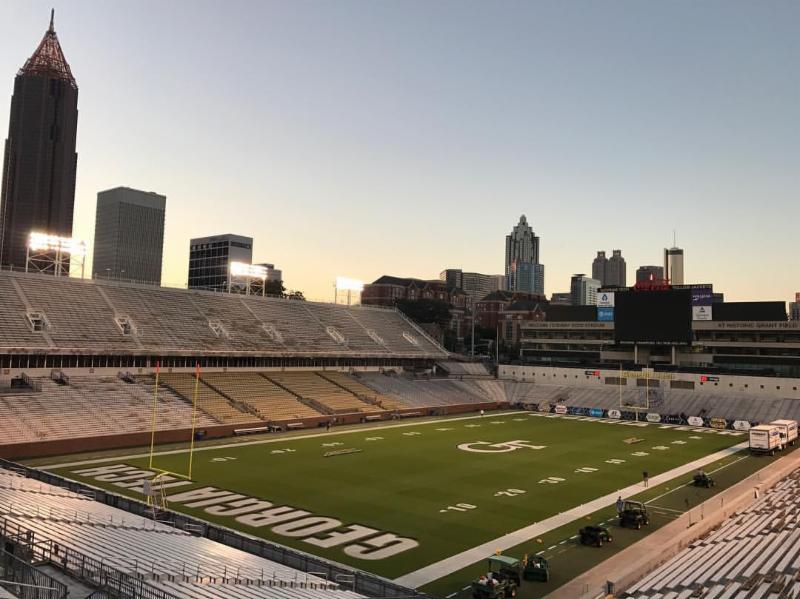These are interesting days indeed for Atlanta United FC. The MLS team is currently living between the truest definition of old and new. On one hand (or foot?), United FC will be one of the first sports teams to play a game in Atlanta’s new crown jewel, Mercedes-Benz Stadium, in September.
But while some of their games will be played in the newest sports stadium in the United States, they are playing in the nation’s oldest college football FBS stadium, Bobby Dodd Stadium, until Mercedes-Benz Stadium is ready for action.
Built in 1913 and the primary home of the Georgia Tech Yellow Jackets, Bobby Dodd is one of five FBS stadiums built at least 100 years ago that is still in use today. Here is the look at college football’s forever five:
Bobby Dodd Stadium, Atlanta, GA (Built 1913)
The oldest continuously-used stadium in FBS, Bobby Dodd also holds the distinction, perhaps not surprisingly, as having hosted the most home-team victories of any stadium in FBS. Georgia Tech played its first game at what was originally named Grant Field on Sept. 27, 1913, with a capacity of 7,000.
By 1919, the stadium had increased in capacity to 25,000 and during that six-year interim, it hosted the most lopsided game in football history, a 222-0 victory over Cumberland College in 1916 without the benefit of throwing a single pass.
The stadium saw its southern and eastern ends fully completed by 1925 and the west side was remodeled in 1947, raising the capacity to 40,000. Upper decks were added in the 1960s, establishing the all-time high capacity of 58,121. Future renovations, including one in the 1980’s that created a new fieldhouse adjacent to the stadium, put the stadium’s capacity at its current 55,000.
Davis Wade Stadium at Scott Field. Starkville, MS (1914)
Davis Wade, home of the Mississippi State Bulldogs, is the second-oldest FBS stadium, behind Bobby Dodd, and the fourth oldest in all of college football, behind Harvard Stadium and Franklin Field. From 1920-2000, the facility was known as Scott Field, in honor of former Bulldog star and U.S. Olympian Don Scott. It was re-named for Floyd Davis Wade in 2001 after the Aflac insurance co-founder made a significant donation toward the stadium’s major expansion that concluded in 2002, increasing the stadium’s capacity by an estimated 10,500 to 55,000, including 50 skyboxes, 1,700 club-level seats and a second upper deck seating 7,000.
The stadium is also hallowed ground for university. The original Bulldog mascot, Bully I, died tragically on campus in 1939 and his remains were buried on the 50 yard-line under the players’ bench.
Vaught-Hemingway Stadium, Oxford, MS (Built 1915)
The home stadium of the University of Mississippi, Vaught-Hemingway is one of two stadiums in the state that are more than a century old, joining Davis Wade Stadium in Starkville. The two stadiums have traded the title of largest stadium in Mississippi several times over the decades, but after Vaught-Hemingway completed an expansion in 2016, it reclaimed the title with a capacity of 64,038.
The stadium went through two major renovations in 1998 and 2002, allowing the Rebels to play all of their home games on campus, instead of farming out their bigger games to a stadium in Jackson. The 2002 expansion added 10,000 seats, including luxury boxes and club seating.
Nippert Stadium, Cincinnati, OH (Built 1915)
Among the list of oldest stadiums, Nippert Stadium, home of the University of Cincinnati Bearcats, is easily the smallest, with a capacity of 40,000. Although the “modern” stadium was not built until 1915, the site began hosting games, with wooden stands, in 1901. A brick and mortar stadium was built on the site in 1915, and though it wasn’t truly completed until 1924, the Bearcats continued to play their games on the site. The original capacity of Nippert Stadium was 12,000.
The field of play was lowered by 12 feet in 1936 to allow for the stadium’s first major expansion to 24,000 seats. A second renovation from 1990-92 increased the capacity to 35,000. A final expansion in 2015 brought the capacity to its current 40,000.
Camp Randall Stadium, Madison, WI (Built 1917)
The Badgers’ celebration of the 100th anniversary of Camp Randall Stadium is already underway. This upcoming week, the University of Wisconsin will begin releasing a list of 100 individuals who shaped the history of the stadium, leading up to their Sept. 1 season opener.
The oldest stadium in use in the Big Ten conference, the stadium draws its name from its location, on the site of Camp Randall, a Union Army training camp during the Civil War. The original capacity was 11,900 in 1917, and now sits at 80,321. Camp Randall was among the first U.S. stadiums to adopt artificial turf in 1968. The Green Bay Packers played 12 exhibition games there between 1986-99, as Camp Randall actually has a larger capacity than Lambeau Field.
Image courtesy Georgia Tech Yellow Jackets football.
This article first appeared in the weekly Football Stadium Digest newsletter. Are you a subscriber? It’s free, and you’ll see features like this before they appear on the Web. Go here to subscribe to the Football Stadium Digest newsletter.

